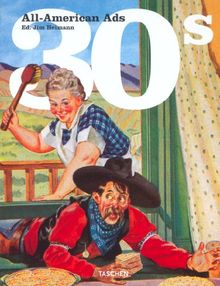
A l'aube des années 1930, le monde généralement
prosaïque de la réclame fut secoué par l'émergence de nouvelles publicités stylisées,
symboliques, voire abstraites, où l'esthétique prenait le pas sur le texte. Hélas, dans un
pays en proie à la dépression, ce vent nouveau fut éclipsé par des techniques de vente
agressives. La subtilité et l'ironie ne faisaient plus vendre dans une nation qui n'arrivait
plus à joindre les deux bouts. Les annonceurs préféraient décrire un avenir radieux dans des
foyers prospères, occultant les difficultés du moment. Gaies et colorées, ces publicités
soutinrent le moral de l'Amérique en crise, promettant bonheur et réussite.
Under his fingers... the reason you'll like Paul Jones!
Hard times, hard sells
"The ads do more than advertise products-they
provide a record of American everyday life of a bygone era in a way that nothing else can."
Associated Press, US
Zoom back in time to the 1930s!
See
original print ads for cars, travel, technology, food, liquor, cigarettes, movies,
appliances, furniture, defense, transportation, you name it - all digitally mastered to look
as bright and colorful as they did on the day they first hit the newsstands.
"This was advertising as an art in its own right, not the plagiarising magpie industry of
today. And its ceaseless sunny optimism in the face of adversity is something from which we
jaded cynics could learn."
World of Interiors, London
At
the dawn of the 1930s, the general trend of literal, uninspired print ads was shaken up by
new, stylized, symbolic, and even abstract advertisements that relied more on aesthetics than
copy. These techniques were overshadowed, however, by the need of a country in the grips of
the depression for hard-sell, shirt-sleeve advertising; subtlety and irony could hardly sell
products to a nation struggling to feed itself. Instead, advertisers strove to paint an
optimistic picture of affluent American family life, revealing nothing of the hard times.
Cheerful and colorful, these ads played an important role as morale boosters, promising
happiness and success to a country in crisis.
Published in the same series
All-American Ads of the 40S
All-American Ads of the 50S
All-American Ads
of the 60S
Forthcoming titles
All-American Ads of the 20S
All-
American Ads of the 70S
Zu Beginn
der dreißiger Jahre
wirbelte ein frischer Wind durch die Werbewelt. War die Werbung in den Printmedien bislang
nüchtern und wenig originell gewesen, so verwendete sie nun auch Stilmittel der
zeitgenössischen Kunst und die Gestaltung wurde wichtiger als der Text. Doch die
Wirtschaftskrise ließ auch die Werbung nicht unberührt: Mit Subtilität und Ironie waren in
einer Zeit, in der die Menschen um die nackte Existenz kämpften, keine Produkte zu verkaufen.
So gab sich die Werbung fröhlich und farbenfroh. Mit ihren Bildern einer heilen Welt bot sie
der Nation in der Krise moralischen Rückhalt.
En los albores de los años treinta,
la tendencia general de una publicidad impresa con mucho texto y poca imaginación se vio
invertida por la aparición de nuevos anuncios estilizados, simbólicos y abstractos que
apostaban más por la imagen que por el texto. No obstante, estas técnicas quedaron eclipsadas
por la necesidad de un país al borde de la depresión de recurrir a una publicidad agresiva.
La sutileza y la ironía no vendían productos a una nación que luchaba por alimentarse. Con
todo, los publicitas procuraron pintar un futuro alentador de vidas desahogadas, ocultando la
realidad de aquellos tiempos difíciles. Coloridos y optimistas, los anuncios insuflaron
esperanza a la población, prometiendo felicidad y éxito a un país en crisis.
1930 (...)